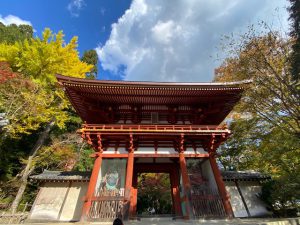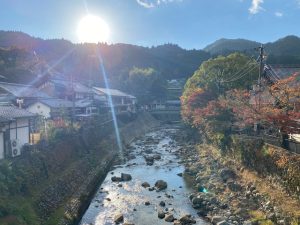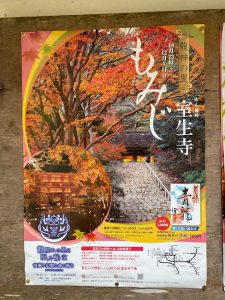彩リレー 再び (愛知県名古屋市千種区姫池通 古美術風光舎 名古屋店 骨董買取致します)
2021.11.05
みなさま、こんにちは。スタッフmです。
スタッフYさんの彩リレーを再度引継ぎまして、今日も紅葉情報を…。

先日、奈良県にあります室生寺(むろうじ)に行って参りました。
室生寺は、奈良時代の680年に天武天皇の勅命をもって修験道の祖・役小角(えんのおづぬ)が初めて建てたと伝えられています。
また、他の文献によると、桓武天皇が皇太子の時に病に臥し、室生山中での延寿祈祷により回復したそうです。
それが縁で、平安初期の延暦年間(782ー806)、天皇の勅命により興福寺(法相宗)の高僧・賢環(けんきょう)が弟子の修圓(しゅえん)とともに建てたと伝えられています。
さらに、承和2年(835)に真言宗の祖・弘法大師空海が遺言された『御遺告(ごゆいこう)』には、唐(中国)の師・恵果から授かった「如意宝珠(にょいほうじゅ)」という国に平和をもたらし、人々の願いをかなえるインド伝来の珠を、室生寺で修業した賢慧(けんね)に託して、善如龍王の棲む精進峰に大切に納めたと伝えられています。
もともと室生の山は、奈良時代すでに『古事記』『日本書紀』に登場する水を司るオカミ(龗、龍を意味する)の神を祀る聖地(ミムロ)であったと考えられています。
つまり、その龍神の神様にこの如意宝珠を捧げるために弘法大師・空海が室生寺にそれを祀ったようです。
その証拠に、室生寺の元々の名前は「善如龍王寺」といったようですよ。
そんなわけで、室生寺はそれ以降、真言宗の重要な道場の一つとして篤い信仰を集めています。
また、弘法大師空海と言えば、高野山に真言宗の総本山、金剛峯寺を建立したことで知られていますが、その高野山も近年までは「女人結界(女人禁制)」が定められ、境内に女性が入ることはかないませんでした。
そうです。女人は修行者の心を乱すからという理由で、聖域への立ち入りを禁止されていたのです。
そんな時代にあっても女性たちを迎えていた「女人高野」と呼ばれるお寺が四つありました。
その一つがこの室生寺でした。

そんな歴史があった室生寺で、当時の女の人に思いを馳せながら境内を散策してきました。
太鼓橋を渡り、受付を済ませると、立派な寶物殿が目に入ります。
こちらは令和の時代に入ってから、仏像仏具の文化財を永く良好な状態で守り、後世に伝えるために建てられたようです。
こちらでは国宝の釈迦如来坐像や十一面観音菩薩立像など、平安時代に作られた仏様を拝むことができます。
釈迦如来坐像は榧の木の一本造りですが、一本の木からこのようなお釈迦様を彫るとは、仏師の頭の中はどうなっていたのか心底驚きました。
そこにはもちろん日々の鍛錬もありますが、神がかったものも感じずにはいられません。
他にも重要文化財など、一度は社会の便覧で見たことがあるようなすごいものばかりが並んでいました。
そして、仁王門から入り、鎧坂を登ると重要文化財の弥勒堂と国宝の金堂が現われます。
また少し登ると国宝の本堂があり、お坊さんの有難いお話が聞けました。
さらにもう少し登ると国宝の五重塔が目の前に…。
こちらは室生寺最古の建物で、平安時代の初期に建てられたものです。
さらに、そこから400段近く階段を登ると、最終ゴールの奥之院です。
途中で何度も休憩しながら、15分近く登りました。
山の頂上にある奥之院から見る景色は素晴らしく、登った甲斐がありました。
また、如意宝珠が祀られているであろう山を有難く拝むこともでき満足して下りてきました。
山の中はそこまで色付いていませんでしたが、室生寺の入り口辺りはモミジやイチョウが色付いていたので、紅葉も楽しむことができました。
室生の地に行き神社仏閣を巡ることが今回の目的でしたが、結果的に彩られた山も見ることができ、行楽の秋にぴったりの小旅行となりました。

「龍隠れの里に眠る秘宝 清流の幻想と命の祈り」Dragon Night Walkというイベントが、11月20日から23日まで行われ、期間中は17時から19時までライトアップもされるようです。
お近くの方はぜひ、行かれてください。きっと綺麗でしょうね…。
Hello everyone. It is staff m.
I took over the Aya relay of staff Y again, and today I will continue to provide information on autumn leaves.
The other day, I went to Murouji Temple in Nara Prefecture.
It is said that Murouji was first built in 680 during the Nara period by En no Gyōja, the founder of Shugendo, under the command of Emperor Tenmu.
According to other documents, Emperor Kanmu fell ill when he was a crown prince and recovered by praying for a long life in the mountains of Murou.
That is the reason why it was built by the high priest Kenkyo of Kofukuji Temple (Hosso sect) with his disciple Shuen during the Enryaku era (782-806) in the early Heian period. It has been reported.
Furthermore, in the second year of Jōwa (835), the founder of the Shingon sect, Kobo Daishi Kukai, made a statement in “Goyuiko”, which was given by the teacher of Tang (China), Huiguo. It is said that the pearls from India that bring peace to the country called “Ihoju” and fulfill the wishes of the people were entrusted to Kenne, who trained at Murouji Temple, and carefully delivered to the Shingon peak where Zennyo Ryuo lives. Has been done.
Originally, the mountain of Murou is thought to have been a sacred place (Mimuro) that enshrines the god of the wolf (meaning dragon, dragon) that controls water that appeared in “Kojiki” and “Nihonshoki” in the Nara period.
In other words, it seems that Kobo Daishi Kukai enshrined it at Murouji Temple in order to offer this jewel to the god of the dragon god.
The proof is that the original name of Murouji is “Zennyo Ryuoji”.
That is why Murouji has since been worshiped as one of the important dojos of the Shingon sect.
Koyasan Kukai is known for having built Kongobuji Temple, the head temple of the Shingon sect, on Mt. Koya, but until recently, Mt. Did not enter.
that’s right. Women were banned from entering the sanctuary because they disturbed the practitioners.
Even in those times, there were four temples called “Women’s Takano” that welcomed women.
One of them was this Murouji temple.
At Murouji Temple, which had such a history, I took a walk in the precincts while thinking of the woman at that time.
After crossing the Taiko Bridge and completing the reception, you will see a magnificent Tomonoden.
It seems that this building was built to protect the cultural assets of Buddhist statues and Buddhist altars in good condition for a long time and pass them on to future generations since the beginning of the Reiwa era.
Here you can worship Buddhas made during the Heian period, such as the sitting statue of Shaka Nyorai, a national treasure, and the statue of the Eleven-faced Kannon Bodhisattva.
The sitting statue of Shaka Nyorai is made of a single tree, but I was really surprised at what happened to the Buddha’s head when carving such a Buddha from a single tree.
Of course, there are daily disciplines, but I can’t help but feel the godliness.
In addition, there were many amazing items such as important cultural properties that I had seen in the social handbook.
Then, when you enter from the Niomon gate and climb the armor slope, you will see the important cultural property Mirokudo and the national treasure Kondo.
After climbing a little, there was the main hall of the national treasure, and I was able to hear the thankful story of the monk.
If you climb a little further, you will see the five-storied pagoda, a national treasure, in front of you.
This is the oldest building in Murouji, built in the early Heian period.
Furthermore, if you climb the stairs for nearly 400 steps from there, you will reach the final goal, Okunoin.
I climbed for nearly 15 minutes, taking breaks many times along the way.
The view from Okunoin on the top of the mountain was wonderful and it was worth climbing.
Also, I was grateful to be able to worship the mountain where the jewels are enshrined, and I was satisfied with the descent.
The mountains were not so colored, but the maples and ginkgo trees were colored around the entrance of Murouji Temple, so I was able to enjoy the autumn leaves.
The purpose of this trip was to go to the land of Murou and visit the shrines and temples, but as a result, I could see the colorful mountains, and it was a perfect excursion for the autumn of the resort.
An event called Dragon Night Walk, “The Hidden Treasure Sleeping in the Village of the Dragon Hidden, the Illusion of the Clear Stream and the Prayer of Life,” will be held from November 20th to 23rd, and will be lit up from 17:00 to 19:00 during the period. ..
If you are near you, please go. I’m sure it’s beautiful …
**********************
少しお寒くなってまいりました。冬物の入れ替えや、整理をされていらっしゃる方もおいでではないでしょうか。
生活様式の変化とともに、大切なお品を整理されている方も多いことと思われます。
ここ風光舎では、古美術品や骨董品の他にも絵画や宝石、趣味のお品など様々なジャンルのものを買受しております。
お片付けをされていて、こういうものでもいいのかしらと迷われているものでも、どうぞお気軽にご相談下さいませ。
風光舎は、出張買取も強化しております。
愛知県内はもちろん、岐阜県・三重県その他の県へも出張いたします。
どんなにご近所の方でもお伺いできますので、まずはお電話お待ちしております。
愛知県名古屋市千種区・骨董 買取
『古美術 風光舎 名古屋店』
TEL 052(734)8444
10:00-17:00 OPEN

